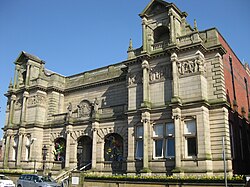| All Saints' Church, Whitefield | |
|---|---|
 West end | |
| 53°33′00″N2°17′55″W / 53.5501°N 2.2986°W | |
| OS grid reference | SD 803 060 |
| Location | Church Lane, Stand, Whitefield, Greater Manchester |
| Country | England |
| Denomination | Anglican |
| Website | www |
| History | |
| Status | Parish church |
| Architecture | |
| Functional status | Active |
| Heritage designation | Grade I |
| Designated | 15 August 1966 |
| Architect | Charles Barry |
| Architectural type | Church |
| Style | Gothic Revival |
| Groundbreaking | 1821 |
| Completed | 1826 |
| Construction cost | £13,729 [1] |
| Specifications | |
| Materials | Millstone grit |
| Administration | |
| Province | York |
| Diocese | Manchester |
| Archdeaconry | Bolton |
| Deanery | Radcliffe and Prestwich |
| Parish | All Saints, Stand |
| Clergy | |
| Rector | Vacancy |
| Laity | |
| Organist/Director of music | Richard Fairclough |
| Churchwarden(s) | Chris Haworth, Chris Dodd |

All Saints' Church or Stand Church is an active Anglican parish church in Stand, Whitefield, Greater Manchester, England. It is in the deanery of Radcliffe and Prestwich, the archdeaconry of Bolton, and the diocese of Manchester. [2] The church is recorded in the National Heritage List for England as a designated Grade I-listed building. [3] It was a Commissioners' church, having received a grant towards its construction from the Church Building Commission. [4] The church is a tall building, standing on high ground, and is constructed on a platform. [1]



